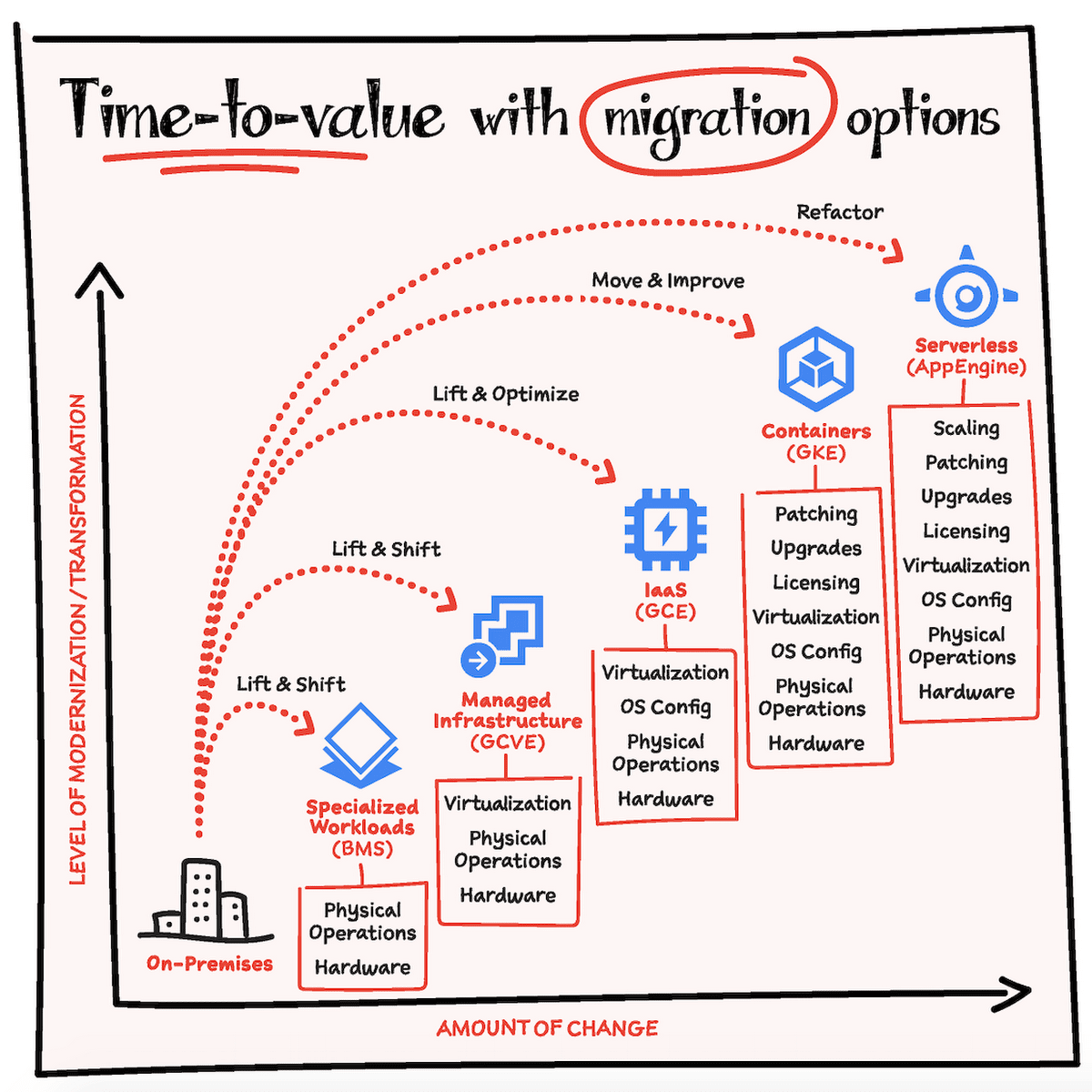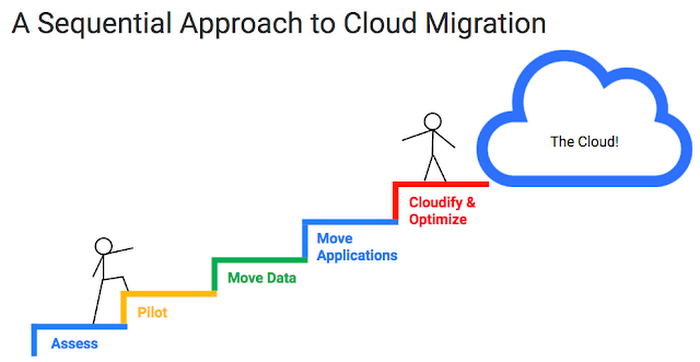If you are considering migrating from on premise to cloud, you are most likely aware of the basic tenets of cloud architecture and you likely know about some services cloud service providers offer.
What you might be wondering is how to prepare before the migration process begins. What on-premise to cloud migration strategy you will need to consider and how to execute it to maximize cost savings.
We have prepared a list of key elements you should remember as well as a handful of questions you need to answer before the beginning of cloud migration. We also have some advice for you on how to make a smooth and successful transition to the cloud from an on-premise solution.
Why are companies migrating to the Google Cloud from on-premise solutions?
Migrating from on premise to cloud solutions can be done for many reasons. Some organizations need to allocate capacity faster and want greater operational flexibility.
Cost optimization
For others, one the main benefits of migrating to the cloud is cost optimzation. When configured properly, solutions based on cloud computing can being significant savings. That’s particularly true for companies who experience high fluctuation in how they utilize their resources. Instead of paying for idle on-premise infrastructure, they scale up and down seamlessly as needed and only pay for the resources they use.
Cost savings also include side expenses, such as electricity used to maintain their own infrastructure, as well as payroll costs – maintaining an on-premise infrastructure requires a specialized skill set.
Data security and compliance
Finally, issues may be the reason for migration related to data security. This last category may seem counter-intuitive, as many organizations wonder if they should move their data to a public or private cloud, or even keep in on-premises in order to maintain a better control of their resources. After all, how can a cloud provided by a third-party company better secure data than our own infrastructure?
It is essential for the continuity of many businesses and having a sound disaster recovery plan allows companies to comply with industry regulation. Cloud resources, no matter where they are, ensure that your data is stored in different locations (redundancy). This way so in the event of a failure, it is easy to recover it.
Cloud migration strategy
Having a well prepared migration strategy can ensure a smooth transition. We can distinguish between a number of cloud migration strategies, both for on premises to cloud migration as well as migration from one public cloud to another, e.g. from an AWS cloud to Google Cloud or to a hybrid cloud solution (e.g. Microsoft Azure and Google Cloud).
Lift and Shift
This is the simplest form of cloud migration as it involves moving your data and resources to a different environment without any significant changes or with only minimal changes to the existing systems. It is a goof data migration option for small organizations with a limited amount of assets and workloads to move.

Improve and Move
This type of migration method involves dealing with legacy systems that are in need of an overhaul before migration. It can be a more time consuming migration strategy than the previous one, but on the other hand in the long run usually pays off in form of savings on infrastructure.
Rip and Replace
This migration strategy involves a complete overhaul of the existing systems and applications before moving them to a new cloud environment. It also requires a deeper understanding of possible migration challenges and therefore a more advanced skillset.
Regardless of which cloud migration strategy a company chooses, it must prepare a plan for both data and systems migration and then follow it in order to ensure a smooth transition from on premise to cloud environment.
Cloud migration fails – why do they occur?
Although the number of cloud migrations is increasing, only a small percentage of them are successful. More than half of migrations exceed the estimated time and budget, and even more than 60% of them end in failure or are interrupted due to difficulties encountered along the way.
One of the reasons why this happens is a lack of proper preparation for migration, which an experienced Google Cloud partner can help with.
Based on a study conducted in February-March 2023, we checked why customers choose FOTC as a Google Cloud Partner and use its migration service. It shows that for most respondents the key was:
- Effectiveness, enabling customers to achieve their business goals thanks to the tools and technical support provided.
- Flexibility, i.e. adaptation to needs and possibilities, and openness to dialogue.
- Credibility related to fulfilling declared promises.
Cloud migration – what do I need to know?
Below we have prepared a list of questions you need to answer before you start to migrate from on-premises to cloud infrastructure. At this stage, the choice of the target solution (the AWS cloud, Azure or Google Cloud, because the following issues are universal:
Where to start migrating?
Before you decide whether you want to complete the migration process with your own resources or with a cloud partner, you need to know: what applications, workloads, databases and services need to be moved and in what order.
At this point, it is important to conduct an inventory of your applications. Gather information about what you currently have. It’s also a good idea to sort your applications according to the effort required to successfully migrate them. Your due diligence in this preparatory step will pay off in later stages of moving to the cloud.
Should I migrate everything at once or is it better to start with smaller sprints?
The answer to this question results directly from the assessment of the current IT environment and, consequently, from the attempt to determine many smaller components. So we need to determine what applications we currently have and how they are integrated.
It is also important to determine the use of resources. When looking at the applications themselves, it is worth grouping them according to their role for the smooth functioning of the company.

The next step is to determine the location of individual applications and verify bandwidth requirements. Only after completing the audit can we determine whether the migration can be carried out as a whole or whether it is better to divide it into smaller sprints.
Account for interdependencies between applications while migration reigns
For the migration to be effective, it is necessary to indicate the applications that can be transferred first, and those requiring additional preparation should be queued for later.
What strategy should you use for legacy applications? Transfer them without modification as part of lift-and-shift, or adapt them to cloud services?
Moving an application from the current solution to the cloud using lift-and-shift does not require changing its architecture, but this is not possible in every case. For more advanced applications that use graphics processors or perform complex calculations, it may be necessary to redesign them to adapt them to work in a distributed server environment.
Sequence of action when migrating from on-premise solutions to the cloud
By answering the above questions, you will gain greater awareness of your pre-migration situation. However, it is worth taking a step back to see the whole process in a broader context. Divide it into four main areas: assessment, plan, migration and optimization, and for each of them do the following:
Rating
- Understand the cloud and migration
- Gather information
- Discover what you need to migrate
Plan
- Sort applications according to the effort needed to migrate
- Map application dependencies
- Pre-validate every migration
Migration
- Run applications in the cloud
- Transfer and sync your data to the cloud
Optimization
- Adapt your application to the possibilities offered by the cloud, instead of maintaining the existing architecture
Completing all stages allows you to organize the process and avoid mistakes. Take advantage of the help of FOTC representatives, who will make the migration even easier. Find out more about all the steps you need to follow when migrating.
